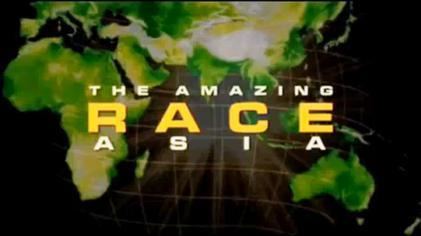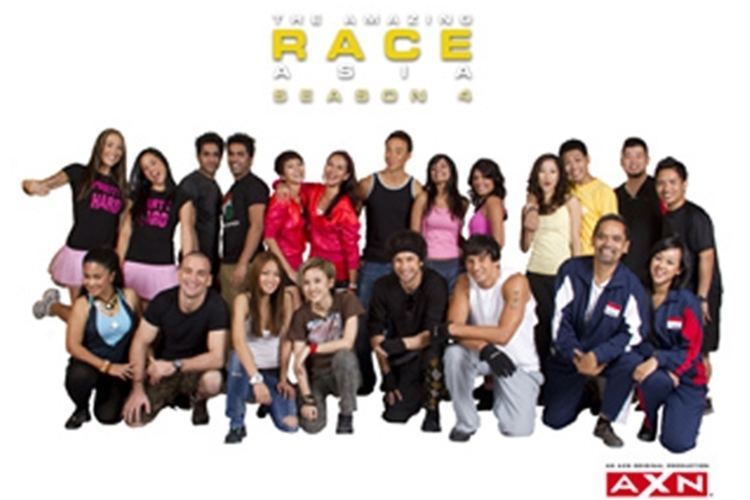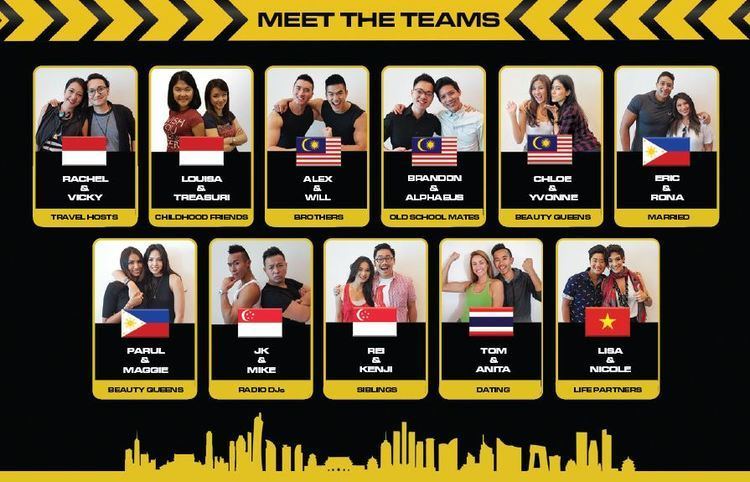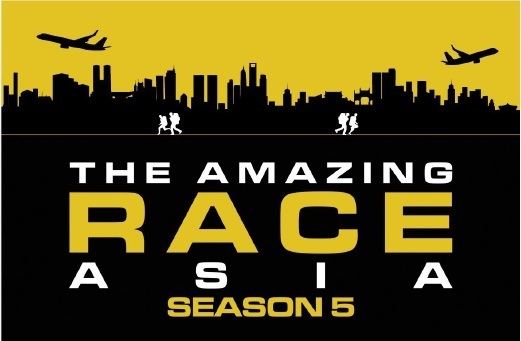7.6 /10 1 Votes
8/10 TV Theme music composer John M. Keane No. of seasons 5 Number of seasons 5 Number of episodes 57 | 7.3/10 IMDb Directed by Michael McKay Original language(s) English First episode date 9 November 2006 Language English | |||||||||||||||||||||||||||||||||
 | ||||||||||||||||||||||||||||||||||
Created by Elise DoganieriBertram van Munster Starring The Amazing Race Asia contestants Nominations International Emmy Award for best Non-Scripted Entertainment Similar The Amazing Race, The Amazing Race Aus, The Amazing Race Ca, The Great Escape, Survivor Profiles | ||||||||||||||||||||||||||||||||||
The Amazing Race Asia is a reality game show based on the American series The Amazing Race.
Contents
- The Race
- Teams
- Route Markers
- Clues
- Obstacles
- Legs
- Non elimination Legs
- Unusual eliminations
- Double length Legs
- Rules and penalties
- Rules
- Penalties
- Seasons
- Rankings
- Countries and locales visited
- Reception
- Awards and Nominations
- Time penalties
- Miscellaneous criticism
- International broadcast
- References
On 17 October 2005, CBS gave other countries the chance to franchise The Amazing Race. The Asian cable TV network AXN Asia was among the first to acquire the rights to produce a version for its territories. The show is produced by Australian television production company ActiveTV, for AXN, in association with Disney Media Distribution (formerly as Buena Vista International Television-Asia Pacific (2006-2007), then Disney-ABC International Television (2007-2010)) and ABC Studios. The host for the show is Singapore based Chinese-American actor Allan Wu.

The ultimate prize is US$100,000, whilst the American show gives away US$1,000,000. The general manager of SPE Networks-Asia which runs AXN, Ricky Ow explained the smaller prize, saying, "It is not really about the money but the adventure and opportunity to be in one of the world's greatest reality shows".

In mid 2016, it was announced that the series will return in late 2016 after a 6-year hiatus. Then it was produced by Sony Pictures Television in the revival series.

The Race

The Amazing Race Asia is a reality television competition between ten teams of two in a race around the world. The race is divided into a number of legs wherein teams travel and complete various tasks to obtain clues to help them progress to a Pit Stop where they are given a chance to rest and recover before starting the next leg twelve hours later. The first team to arrive at a Pit Stop is often awarded a prize while the last team is normally eliminated from the race (except in non-elimination legs, where the last team to arrive may be penalised in the following leg). The final leg of each race is run by the last three remaining teams, and the first to arrive at the final destination wins the US$100,000 cash prize.
Teams

Each team is composed of two individuals who have some type of relationship to each other. A total of 80 participants have joined The Amazing Race Asia, many of which have been celebrities in their native country.
Because of the various languages spoken around Asia and the fact that the show is broadcast on an English-language network, participants are all required to be able to communicate in English. The contestants chosen to appear are from various Asian countries and not limited to one country of origin. Participating countries include all citizens of the continent of Asia except the Middle East, Myanmar, Laos, North Korea, Russia and East Timor, but including Pakistan, Palau, Fiji and the Maldives as well as non-Asian workers who are living in Asia for a long period of time. From season 2 onwards, Japanese residents were eligible to participate, having been ineligible for season 1.
Route Markers
Route Markers are yellow and red flags that mark the places where teams must go. Most Route Markers are attached to the boxes that contain clue envelopes, but some may mark the place where the teams must go in order to complete tasks, or may be used to line a course that the teams must follow. Route Markers were, however, coloured yellow and white in the second leg of season 3 to avoid confusion with the flag of South Vietnam.
Clues
Clues are found throughout the race in sealed envelopes, normally inside clue boxes. They give teams the information they need and tasks they need to do in order for them to progress through the race.
Obstacles
Teams may encounter the following that may affect their position during the race:
In seasons 3 and 4, both the Yield and the U-Turn were seen in separate legs (the U-Turn replaced the Yield in the 12th season of the American version) and since a team can use each once during the Race, it is therefore possible for a single team to use their U-Turn power even if they have already used their Yield power in a prior leg (Geoff and Tisha, season 3). In season 5, both of the Yield and U-Turn were featured and used in a same leg, marking the first ever season in all The Amazing Race franchise to feature Yield and U-Turn in the same leg.
Legs
At the beginning of each leg, teams receive an allowance of cash, usually in U.S. dollars, to cover expenses during the race (except for the purchase of airline tickets, which are paid-for by credit cards provided to the teams). Teams penalised for being last in certain non-elimination legs have to surrender all of their money and will not receive any allowance on the next leg.
Teams then have to follow clues and Route Markers that will lead them to the various destinations and tasks they will face. Modes of travel between these destinations include commercial and chartered airplanes, boats, trains, taxis, buses, and rented vehicles provided by the show, or the teams may simply travel by foot. Each leg ends with a twelve-hour Pit Stop where teams are able to rest and where teams that arrive last are progressively eliminated from the race until only three remain. In some legs, the first teams to arrive at the Pit Stop win prizes, usually from the show's sponsors.
In season 1, all teams were required to take race-sponsored AirAsia flights as opposed to choosing whatever airline they wished.
The clue which directs a team to the Finish Line mentions it not as such but as a "Final Pit Stop." Instead of having an elevated red carpet with The Amazing Race logo enlarged on it as in the American edition, the Finish Line consists only of a regular check-in mat for the final three teams.
Non-elimination Legs
Each race has a number of predetermined non-elimination legs, in which the last team to arrive at the Pit Stop is not eliminated and is allowed to continue on the race.
In all seasons except the third and fifth, the first leg was a non-elimination leg. By comparison, the fifteenth season of the American version was the first season to have the first leg being a non-elimination one, although there was an elimination at the start of that season's Race. Before this, the first leg had always been an elimination one. The first season that has a non-elimination leg in the of the American one that has no one being eliminated at first is season 18.
Stripped of money and belongings
In season 1 through three, the last team to check in was stripped of all their money and was not given any money at the start of the next leg, forcing that team to literally beg for money from the local population of the city they were in for such expenses as cab, bus, or train fare.
Marked for elimination
Used in season 2, a team that comes in last on a non-elimination leg were "marked for elimination"; if they did not come in first on the next leg, they would receive an immediate 30-minute penalty upon checking in at the mat, possibly allowing other teams to catch up and check in ahead of them at the pit stop during their penalty time; if all the trailing teams were to check in during the penalty, the penalized team could fall to last place and could be eliminated unless they receive another penalty at the end of the next leg. The marked for elimination penalty was discontinued in season 5 and was replaced by Speed Bump
Speed Bump
Started from season 5, the penalty for finishing last in a non-elimination leg is that the affected team will have to perform a "Speed Bump" task at some point during the next leg. Teams would be alerted to the upcoming Speed Bump by a Route Marker clue prior to it, while the Speed Bump itself is displayed in a manner similar to the Yield showing the affected team's picture at a stand near to the regular Route Marker. Once the team completes the Speed Bump task, they may receive the next clue that they would have gotten at the Route Marker, or they may have to backtrack to the location of the clue box to get their next clue, depending on the task. If the team fails to complete the Speed Bump, they will receive a four-hour penalty at the Pit Stop. The tasks that teams have been called on to perform are generally not very difficult or time-consuming, and the majority of teams that have been hit by the Speed Bump have recovered from it quickly enough to avoid immediate elimination.
Unusual eliminations
Double-length Legs
Like in the show's American counterpart, the Amazing Race Asia often features double-length legs or "superlegs". These occur when a team reaches a Pit Stop only for Allan to hand them another clue and order them to continue racing.
In season 1, teams were told to "Find Allan Wu" only to find out that it was not a Pit Stop. In this season, a "superleg" is merely one leg that is longer than the other legs.
In seasons 2 and 4, these checkpoints were alluded to being normal Pit Stops with on-screen graphics displaying "Proceed to Pit Stop". This was so that viewers wouldn't guess that a superleg was coming up. Once the checkpoint had been revealed to be a continuation point, Allan referred to them as "Virtual Pit Stops". Clues the teams received however did not mention them as such, as Jess and Lani in Season 4 are seen reading "Allan Wu awaits". These "superlegs" consist of two separate legs joined by the Virtual Pit Stop which is counted as a regular Pit Stop.
Rules and penalties
Most of the rules and penalties are adopted directly from the American edition; but in some of cases, the Asian version has been seen to have a unique set of additional rules.
Rules
Penalties
Seasons
The show first aired in 2006 with the first season premiere airing in November 2006 and ending in February 2007. The first three seasons were aired yearly, but season 4 was delayed by a year and returned to television in 2010.
Rankings
This is a list of rankings of the team's countries on The Amazing Race Asia
indicates the winning country. indicates the runner-up country. indicates the third-place country. indicates the country did not participate.Countries and locales visited
As of 15 December 2016, The Amazing Race Asia has visited 20 countries and has visited 4 continents.
Reception
The premiere episode of Season 1 was highly successful and was the No. 1 show in its timeslot in Singapore and Malaysia and No. 2 in the Philippines, as well as No.1 in its timeslot for Adults 18-39 in New Zealand. The ratings for the finale of its second season increased over that of Season 1 in Malaysia and Singapore. In Season 3 the show reached 18.8 million viewers in selected countries, and in its first three seasons it reached over 34 million viewers across Asia. It was the highest rated program of its timeslot among all international channels in Singapore, Malaysia, the Philippines and Hong Kong. The fourth season of The Amazing Race Asia, where the Philippines team Richard & Richard won, has seen a 71% increase in average ratings over the previous season in the Philippines.
Awards and Nominations
The show has won consecutive Asian Television Awards for "Best Adaptation of an Existing Format" in 2008 and 2009. Its third season was nominated for an International Emmy in 2009.
Time penalties
Season 1 has seen a greater use of time penalties. While time penalties were generally served prior to the team being allowed to check into the Pit Stop (therefore possibly pushing them down the ranking lists and opening them to a possible last place finish and certain elimination, as was the case with Sahil & Prashant in Leg 5, Season 1), controversy has arisen over the fact that some time penalties are served at the beginning of the next leg.
This was the case with Andy & Laura, who departed the Chard Farm Winery Pit Stop in Queenstown at the start of Leg 7 with a 92-minute time penalty as a result of Andy's speeding in Leg 6. Had this 92-minute penalty been applied prior to Andy & Laura being allowed to check into the Pit Stop at the end of Leg 6, it would have pushed them into last place and certain elimination. Melody & Sharon, who were eliminated in that leg of the Race revealed in a press interview that they were really shocked that this 'speeding rule' did not apply at the Pit Stop, despite having learnt how the rules could be applied.
Miscellaneous criticism
Despite the success of the first season, many fans criticised that teams did not always "self-drive" to their next destination. Fans also criticised the fact that teams were always clumped in the same flight. This was according to an interview with Wu. The second season promised to tackle these issues. Others have criticized the show for blatant commercialism of their sponsors on the show. This is most prevalent in tasks that involve the use of high definition cameras as well as the prizes of leg races that are usually technological gadgets supplied by sponsors, rather than vacations and trips like the show's American counterpart (which is sponsored by Travelocity). The executive producer and co-creator of The Amazing Race, Bertram van Munster, conceded that there were more product placement, but said that they had much less money to work with for The Amazing Race Asia, that he was "not too crazy about blatant product placement, but the bill has to be paid." There was also criticism in the ambiguity of clues and the supposed impossibility of completing some of the tasks in season 1, in particular the roadblock in Leg 3 which saw 5 out of the 9 teams fail to complete the roadblock. In addition, ambiguous clues like 'you know it when you see it' led to some teams going around in circles searching for clues.
International broadcast
In 2010, The first three seasons of the show premiered with Hungarian voiceovers in Hungary on AXN Hungary and Animax Eastern Europe as "The Amazing Race Ázsia" on Saturday and Sunday afternoons from 7 February.
